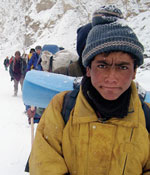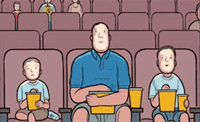
Spring Issue: The End of Ice
Our Spring 2009 issue is showing up in mailboxes around the country this week, and the entirety of the issue is available on our website, with about a third of it available to non-subscribers. The theme is “The End of Ice,” with our contributors reporting from around the globe about how climate change is affecting the coldest parts of the world. Some of the works on this topic include:
- Jason Anthony writes about “living at the bitter end of civilization” in Antarctica, describing what it was like to live in remote camps on the continent for a decade.
- The Snow Star—a glacier in the Andes—is fast melting, and the Quechua believe that when the glaciers melt, the world will end. Carolyn Kormann joins thousands of Peruvians for their annual religious festival honoring “El Señor de Qoyllur Rit’i,” the God of the Snow Star, whom they believe lives in the glacier.
- Ted Conover joins Zanskar villagers to walk the forty-mile chaddar—ice road—that is their only route to civilization for much of the year. Each year the ice freezes later and melts earlier, and the danger becomes greater.
- Tipper Gore photographs Bishop Glacier in British Columbia, which is, like most glaciers, collapsing rapidly. “If you happen to be there at just the right time, you can see global warming exacting its toll right before your eyes.”
- Can we engineer a solution to the climate crisis? Some climate researchers are advocating the dispersal of sulfate directly into the stratosphere to cool the earth, like a volcanic eruption does. Pat Joseph talks to the folks involved in this debate to see if it’s a good idea. (Spoiler: No.)
- Paul Reyes joins iceberg hunters in Newfoundland, who fire solid slugs from shotguns to slough off huge chunks, which they sell to a a liquor company who makes “the purest vodka on the planet.”
We also have Eric Wilson on collectors of film prints, Dimiter Kenarov on the capture of a Macedonian serial killer, William Finnegan on Mi’kmaq blueberry rakers in Maine, Lawrence Weschler on Trevor and Ryan Oakes’ radical breakthroughs in the rendering of three-dimensional space in art, and the fourth installment of Chris Ware’s “Jordan W. Lint,” his serialized pictorial fiction.
On the fiction front, we’ve got Jessica Francis Kane’s “The Inquiry,” her story of a WWII-era London air raid drill gone wrong, and Kent Nelson’s “The Spirit Bird,” about birdwatching in coastal Alaska.
There’s lots of poetry in this issue. David Baker, Elizabeth Bradfield, Rita Dove, Eamon Grennan, Jim Harrison, Walter Jost, Sara Pennington, Kevin Prufer, R.T. Smith, Stefi Weisburd, and Anna Pierson Wiese all contribute work, with several poems along the theme of the issue.
We’ve got a pair of book reviews, one from Oscar Villalon on What Blood Won’t Tell: A History of Race on Trial in America, and the other from Blake Bailey on Flannery: A Life of Flannery O’Connor, plus the usual array of shorter book notes.
For this issue we’ve created a few online features, and two are available now. Andrew Shelden has put together a history of VQR’s relationship with H.L. Mencken, to provide the context for our publication of “The South Astir” in our Winter 1935 issue. And Andrew Shelden and Jon Schneider put together a history of our relationship with Katherine Anne Porter, who was a regular contributor to the publication in the mid 1930s. She was particularly insistent that we publish “The Grave” in our tenth anniversary issue, since it focused on “Southern letters.”
If you can’t wait to make this 216-page issue yours, order a copy right now, or start with this issue when you subscribe today.



